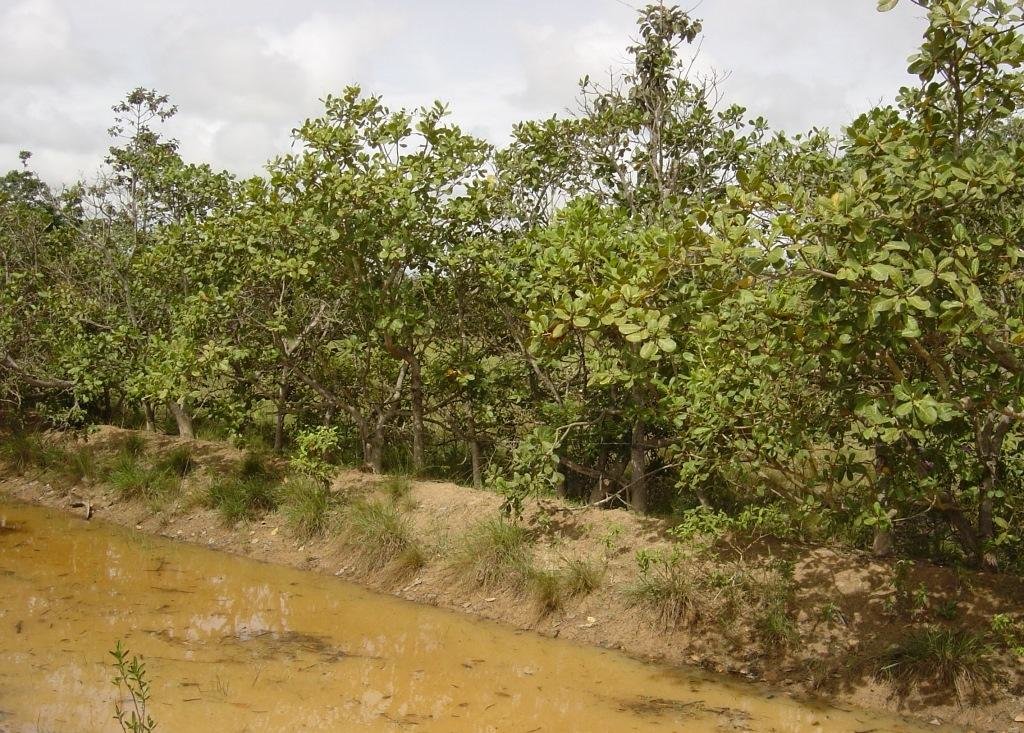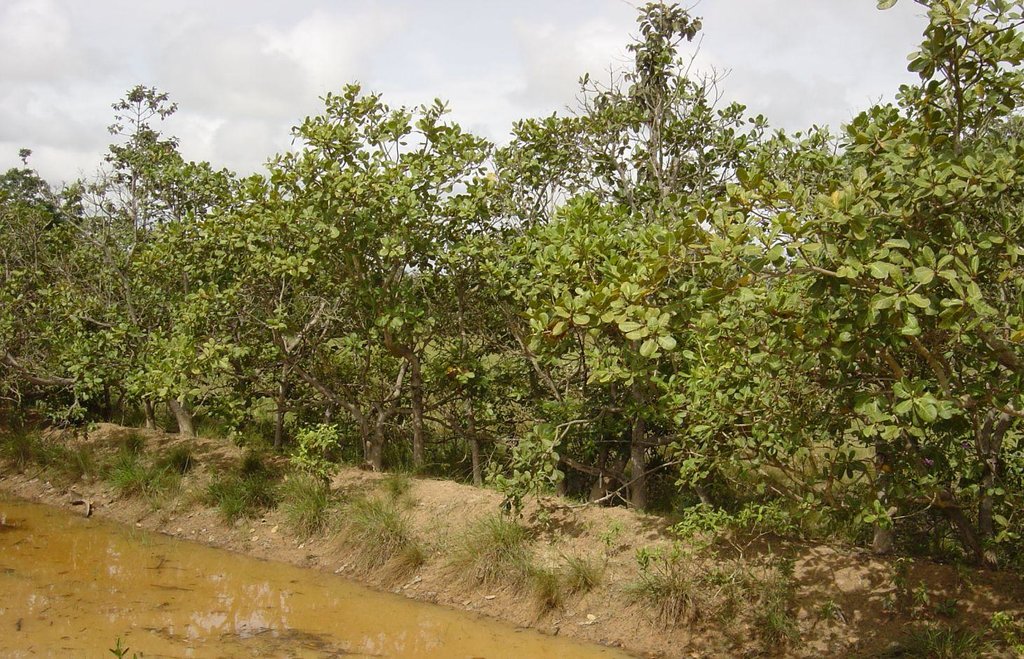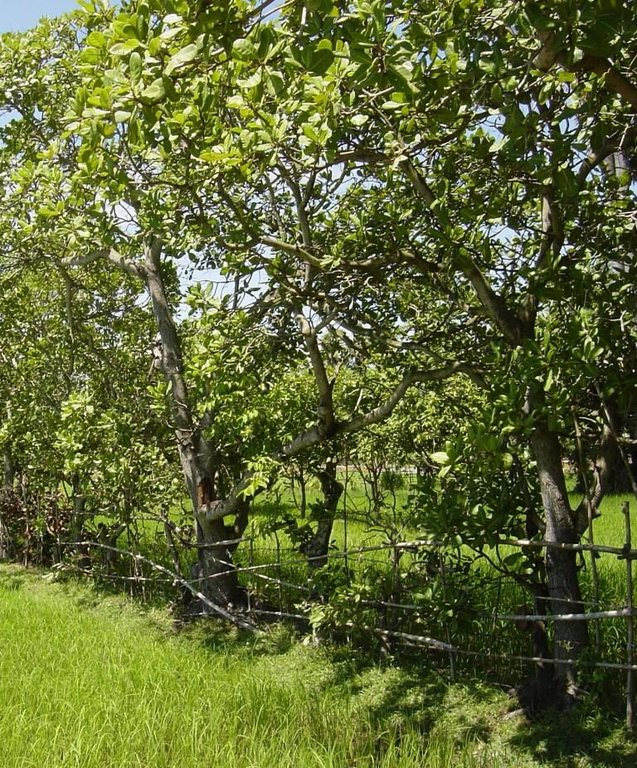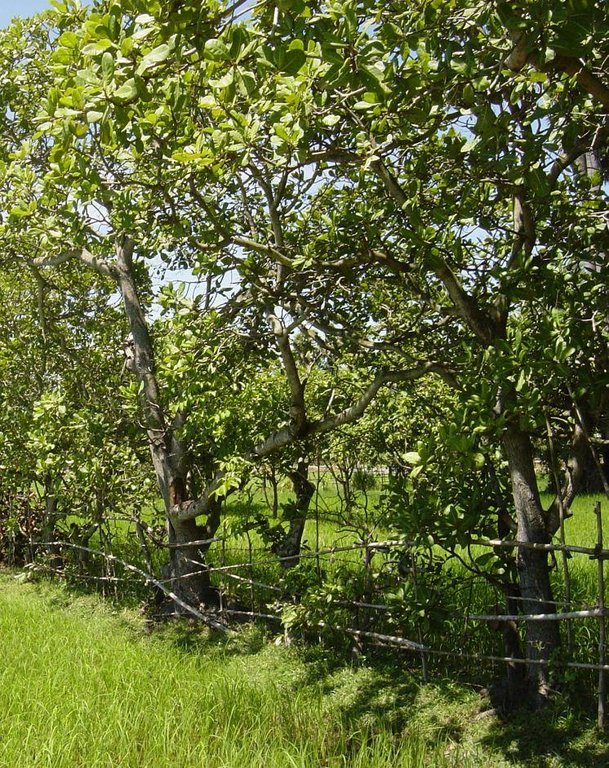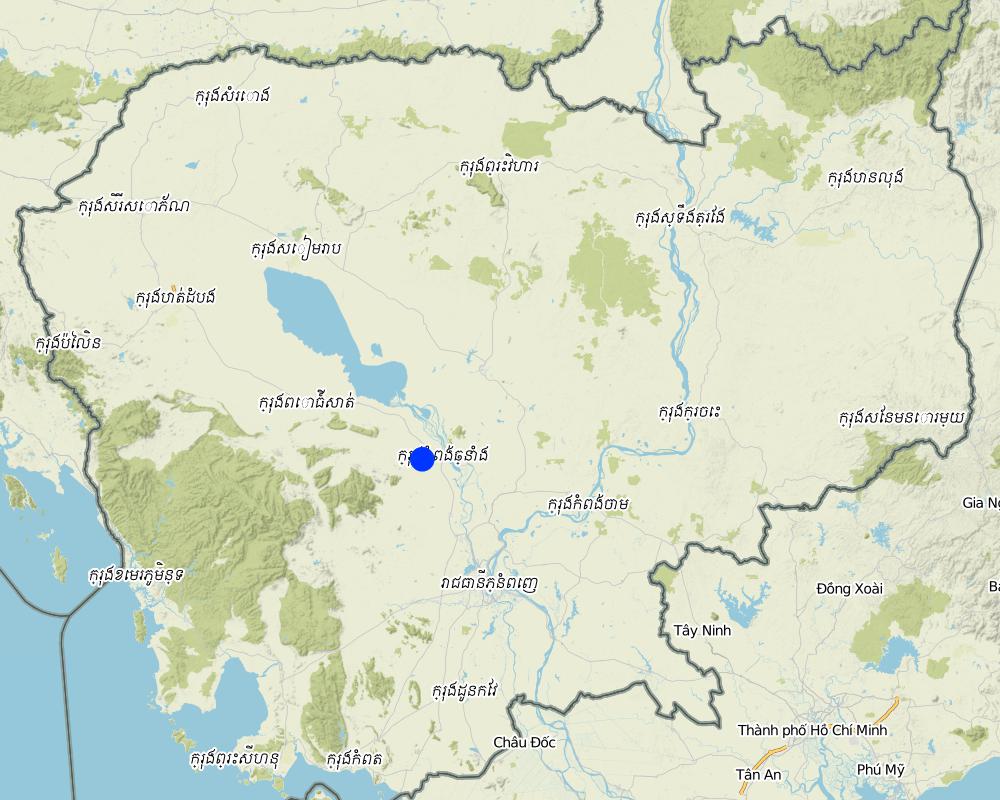Cashew living fences [Cambodia]
- Creation:
- Update:
- Compiler: Stefan Graf
- Editor: –
- Reviewers: Deborah Niggli, Alexandra Gavilano
ដំណំាចន្នីដំាជារបងរស់ (Khmer)
technologies_1643 - Cambodia
View sections
Expand all Collapse all1. General information
1.2 Contact details of resource persons and institutions involved in the assessment and documentation of the Technology
SLM specialist:
Khun Lean Hak
SOFDEC/LAREC, www.sofdec.org
Cambodia
SLM specialist:
Sreytouch Bin
SOFDEC
Cambodia
SLM specialist:
Pith Khonhel
LAREC
Cambodia
Name of the institution(s) which facilitated the documentation/ evaluation of the Technology (if relevant)
Society for Community Development in Cambodia (SOFDEC) - CambodiaName of the institution(s) which facilitated the documentation/ evaluation of the Technology (if relevant)
Local Agricultural Research and Extension Centre (LAREC) - Cambodia1.3 Conditions regarding the use of data documented through WOCAT
The compiler and key resource person(s) accept the conditions regarding the use of data documented through WOCAT:
Yes
1.4 Declaration on sustainability of the described Technology
Is the Technology described here problematic with regard to land degradation, so that it cannot be declared a sustainable land management technology?
No
2. Description of the SLM Technology
2.1 Short description of the Technology
Definition of the Technology:
Living fences of cashew, reinforced with bamboo and/or barbed wire, are used to keep the cattle off the garden or the rice seedbed.
2.2 Detailed description of the Technology
Description:
Cashews (Anacardium occidentale) are fast growing, waterlogging tolerant tropical trees that can be used as living fences. The cashews act as fence posts, and are reinforced with bamboo poles and/or barbed wire. The living fences are used to either fence cattle into fields or fence them off, usually around the house. The fenced areas can be planted during the dry season. Without fences, the cattle are free roaming and use to destroy the crops.
Besides fencing the cattle, the purposes of cashew living fences are the production of nuts and fruits, fuel, and soil enhancer. The nuts are sold, but there is no market for the fruits, thus they are fed to cattle or let to rot. The wood is used to cook or to produce charcoal; the ash is added to the compost. The leaves are gathered as well and added to the compost.
Although cashews can stand waterlogged conditions, they prefer a well-drained soil. Thus a small berm is built up on the emplacement of the fence, and sown with cashew seeds spaced from 0.5 to 3 m. Cashews grow faster when directly sown than when transplanted. The spacing varies according to the farmers’ purpose. If a higher production of nuts is intended, the spacing is wider; if the fence is more important, the plants are grown closer. Cattle do not eat the leaves and branches, thus do not need protection from grazing. One year after sowing the cashews, the trees are tall enough to act as fence posts and support bamboo pole as well as barbed wire. The bamboo is either gathered from the wild or grown in the fields and home gardens. The bamboo is fixed to the living posts with natural fibers/vines or old clothes, and has to be replaced every two to three years to withstand cattle.
The analysed area is flat (slope < 2%), with a tropical climate (dry season from November to May and wet season from June to October), and the soils are mostly sandy or loamy. The soil has a low fertility, contains little organic matter, and acidifies. The area has been deforested a long time ago, and the groundwater table is rather high (1-2 m during the dry season, on the surface during wet season).
Due to climate change, farmers notice more erratic rainfalls, temperature rises and more recurrent droughts. Rice is the predominant crop grown in the area, since it serves as staple food (mix subsistence and commercial activities). Cattle are usually grazing on the fields after the harvest, without much control. Thus the cattle grazes too often and too much on the same spot, leading to degradation.
The increasing migration rate (the young generation leaves the villages to work in the cities, garment industry or abroad) results in a decrease of available labour force in the area which has detrimental effects on the agricultural activities. Furthermore, the civil war in the 1970s (Khmer Rouge) led to the loss of agricultural knowledge. Several NGOs are trying to re-establish the knowledge.
2.3 Photos of the Technology
2.5 Country/ region/ locations where the Technology has been applied and which are covered by this assessment
Country:
Cambodia
Region/ State/ Province:
Kampong Chhnang
Further specification of location:
Krang Liav, Rolea Pha-er
Specify the spread of the Technology:
- evenly spread over an area
If precise area is not known, indicate approximate area covered:
- < 0.1 km2 (10 ha)
Comments:
Around 15 farmers in this village use cashew living fences.
Map
×2.6 Date of implementation
If precise year is not known, indicate approximate date:
- 10-50 years ago
2.7 Introduction of the Technology
Specify how the Technology was introduced:
- through land users' innovation
3. Classification of the SLM Technology
3.1 Main purpose(s) of the Technology
- conserve ecosystem
3.2 Current land use type(s) where the Technology is applied
Land use mixed within the same land unit:
Yes
Specify mixed land use (crops/ grazing/ trees):
- Silvo-pastoralism

Cropland
- Tree and shrub cropping
Tree and shrub cropping - Specify crops:
- cashew

Grazing land
Comments:
Major land use problems (compiler’s opinion): Overgrazing, low soil fertility, sandy soils, monocultures, soil left bare after ploughing, wind and dust storms.
Major land use problems (land users’ perception): Low soil fertility, water scarcity, droughts.
Number of growing seasons per year: 1
Longest growing period in days: 210, Longest growing period from month to month: June to December
Livestock density: 25-50 LU /km2
3.4 Water supply
Water supply for the land on which the Technology is applied:
- mixed rainfed-irrigated
3.5 SLM group to which the Technology belongs
- integrated crop-livestock management
3.6 SLM measures comprising the Technology

vegetative measures
- V1: Tree and shrub cover
Comments:
Type of vegetative measures: aligned: -along boundary
3.7 Main types of land degradation addressed by the Technology

soil erosion by wind
- Et: loss of topsoil

chemical soil deterioration
- Cn: fertility decline and reduced organic matter content (not caused by erosion)

biological degradation
- Bc: reduction of vegetation cover
- Bl: loss of soil life
Comments:
Main causes of degradation: soil management (Plowing of soil, then left bare), crop management (annual, perennial, tree/shrub) (Mainly annuals (rice) planted in monocultures.), overgrazing (Uncontrolled grazing.), labour availability (Little labour availability, mainly due to work in garment industry)
3.8 Prevention, reduction, or restoration of land degradation
Specify the goal of the Technology with regard to land degradation:
- reduce land degradation
- restore/ rehabilitate severely degraded land
4. Technical specifications, implementation activities, inputs, and costs
4.1 Technical drawing of the Technology
Technical specifications (related to technical drawing):
On a dike cashews (Anacardium occidentale) were planted a few years back. After they grew up, the fence was done with barbed wire and bamboo poles.
Kampong Chhnang
Date: 2014
Technical knowledge required for field staff / advisors: low
Technical knowledge required for land users: low
Main technical functions: increase of biomass (quantity), spatial arrangement and diversification of land use
Secondary technical functions: increase in organic matter, increase in nutrient availability (supply, recycling,…), improvement of water quality, buffering / filtering water, reduction in wind speed
Aligned: -along boundary
Vegetative material: T : trees / shrubs, F : fruit trees / shrubs
Vertical interval within rows / strips / blocks (m): 0.5-3m
Fruit trees / shrubs species: Cashew, seeded.
Author:
Stefan Graf, Switzerland
4.2 General information regarding the calculation of inputs and costs
Indicate average wage cost of hired labour per day:
5.00
4.3 Establishment activities
| Activity | Timing (season) | |
|---|---|---|
| 1. | Building small bound to sow the cashews. | Dry season, before sowing |
| 2. | Sowing cashews on the bounds | Beginning of rainy season |
| 3. | Gathering bamboo in the forest, building the fence |
4.4 Costs and inputs needed for establishment
| Specify input | Unit | Quantity | Costs per Unit | Total costs per input | % of costs borne by land users | |
|---|---|---|---|---|---|---|
| Labour | labour | 1.0 | 17.5 | 17.5 | 100.0 | |
| Equipment | tools | 1.0 | 12.0 | 12.0 | 100.0 | |
| Equipment | barbed wire | 1.0 | 21.0 | 21.0 | 100.0 | |
| Plant material | seeds | 1.0 | 1.0 | 1.0 | 100.0 | |
| Total costs for establishment of the Technology | 51.5 | |||||
| Total costs for establishment of the Technology in USD | 51.5 | |||||
Comments:
Duration of establishment phase: 12 month(s)
4.5 Maintenance/ recurrent activities
| Activity | Timing/ frequency | |
|---|---|---|
| 1. | Gathering bamboo in the forest, building the fence | Every 2-3 years |
4.6 Costs and inputs needed for maintenance/ recurrent activities (per year)
| Specify input | Unit | Quantity | Costs per Unit | Total costs per input | % of costs borne by land users | |
|---|---|---|---|---|---|---|
| Labour | labour | 1.0 | 3.0 | 3.0 | 100.0 | |
| Total costs for maintenance of the Technology | 3.0 | |||||
| Total costs for maintenance of the Technology in USD | 3.0 | |||||
Comments:
Machinery/ tools: Hoe, hatchet.
The costs were calculated for 100 m of living fence, with 2 stripes of barbed wires. The barbed wire is not necessary if enough labour and bamboo is available but makes it easier to keep the cattle fenced and requires less maintenance than bamboo poles.
4.7 Most important factors affecting the costs
Describe the most determinate factors affecting the costs:
The costs are most determined by the availability of bamboo. If it is not grown in the garden, it has to be gathered in the forest that is related to time consuming transportation. Or barbed wire has to be purchased.
Note: The time used to gather the leaves for the compost or to cut the branches to make charcoal/ash as soil amendment was not included in the recurrent activities as these activities are neither related to the main purpose of living fences nor done by all the farmers applying this technology.
5. Natural and human environment
5.1 Climate
Annual rainfall
- < 250 mm
- 251-500 mm
- 501-750 mm
- 751-1,000 mm
- 1,001-1,500 mm
- 1,501-2,000 mm
- 2,001-3,000 mm
- 3,001-4,000 mm
- > 4,000 mm
Specifications/ comments on rainfall:
1486.45 mm 2013 in Kampong Chhnang
Agro-climatic zone
- sub-humid
Thermal climate class: tropics. 27-35°C
5.2 Topography
Slopes on average:
- flat (0-2%)
- gentle (3-5%)
- moderate (6-10%)
- rolling (11-15%)
- hilly (16-30%)
- steep (31-60%)
- very steep (>60%)
Landforms:
- plateau/plains
- ridges
- mountain slopes
- hill slopes
- footslopes
- valley floors
Altitudinal zone:
- 0-100 m a.s.l.
- 101-500 m a.s.l.
- 501-1,000 m a.s.l.
- 1,001-1,500 m a.s.l.
- 1,501-2,000 m a.s.l.
- 2,001-2,500 m a.s.l.
- 2,501-3,000 m a.s.l.
- 3,001-4,000 m a.s.l.
- > 4,000 m a.s.l.
5.3 Soils
Soil depth on average:
- very shallow (0-20 cm)
- shallow (21-50 cm)
- moderately deep (51-80 cm)
- deep (81-120 cm)
- very deep (> 120 cm)
Soil texture (topsoil):
- coarse/ light (sandy)
- medium (loamy, silty)
Topsoil organic matter:
- medium (1-3%)
- low (<1%)
5.4 Water availability and quality
Ground water table:
on surface
Availability of surface water:
good
Water quality (untreated):
poor drinking water (treatment required)
Comments and further specifications on water quality and quantity:
During wet seasons
5.5 Biodiversity
Species diversity:
- medium
Habitat diversity:
- medium
5.6 Characteristics of land users applying the Technology
Market orientation of production system:
- mixed (subsistence/ commercial)
Off-farm income:
- 10-50% of all income
Relative level of wealth:
- average
Individuals or groups:
- individual/ household
Level of mechanization:
- manual work
- animal traction
Gender:
- women
- men
Indicate other relevant characteristics of the land users:
Land users applying the Technology are mainly common / average land users
Population density: 10-50 persons/km2
Annual population growth: 0.5% - 1%
Off-farm income specification: handicraft, remittances and factory work
5.7 Average area of land used by land users applying the Technology
- < 0.5 ha
- 0.5-1 ha
- 1-2 ha
- 2-5 ha
- 5-15 ha
- 15-50 ha
- 50-100 ha
- 100-500 ha
- 500-1,000 ha
- 1,000-10,000 ha
- > 10,000 ha
Is this considered small-, medium- or large-scale (referring to local context)?
- medium-scale
5.8 Land ownership, land use rights, and water use rights
Land ownership:
- communal/ village
- individual, not titled
Land use rights:
- communal (organized)
- individual
Water use rights:
- open access (unorganized)
Comments:
Land users have a title that is not recognized by the state.
5.9 Access to services and infrastructure
health:
- poor
- moderate
- good
education:
- poor
- moderate
- good
technical assistance:
- poor
- moderate
- good
employment (e.g. off-farm):
- poor
- moderate
- good
markets:
- poor
- moderate
- good
energy:
- poor
- moderate
- good
roads and transport:
- poor
- moderate
- good
drinking water and sanitation:
- poor
- moderate
- good
financial services:
- poor
- moderate
- good
6. Impacts and concluding statements
6.1 On-site impacts the Technology has shown
Socio-economic impacts
Production
crop production
Comments/ specify:
Due to shading and root competition.
wood production
Comments/ specify:
Used as fuel and charcoal.
energy generation
Comments/ specify:
Firewood production.
Water availability and quality
demand for irrigation water
Comments/ specify:
Quality, trough bioremediation of groundwater. Difficult to quantify.
Income and costs
diversity of income sources
Comments/ specify:
If spaced, production of cashew nuts and apples.
Socio-cultural impacts
food security/ self-sufficiency
Comments/ specify:
Improved self-sufficiency on firewood.
contribution to human well-being
Comments/ specify:
Every additional income source/diversification increases the human well-being.
Ecological impacts
Water cycle/ runoff
evaporation
Comments/ specify:
But increased evapotranspiration.
Soil
nutrient cycling/ recharge
Comments/ specify:
Nutrients are picked up from the groundwater, and put back into the cycle.
soil organic matter/ below ground C
Comments/ specify:
Leaves used for compost.
Biodiversity: vegetation, animals
biomass/ above ground C
beneficial species
Comments/ specify:
Wormcasts could be seen under the trees. Difficult to quantify.
habitat diversity
Comments/ specify:
Tree layer.
Climate and disaster risk reduction
wind velocity
6.2 Off-site impacts the Technology has shown
groundwater/ river pollution
Comments/ specify:
Bioremediation difficult to quantify.
wind transported sediments
Comments/ specify:
Slowing down of wind speed.
6.3 Exposure and sensitivity of the Technology to gradual climate change and climate-related extremes/ disasters (as perceived by land users)
Gradual climate change
Gradual climate change
| Season | increase or decrease | How does the Technology cope with it? | |
|---|---|---|---|
| annual temperature | increase | well |
Climate-related extremes (disasters)
Meteorological disasters
| How does the Technology cope with it? | |
|---|---|
| local rainstorm | well |
| local windstorm | well |
Climatological disasters
| How does the Technology cope with it? | |
|---|---|
| drought | well |
Hydrological disasters
| How does the Technology cope with it? | |
|---|---|
| general (river) flood | well |
Other climate-related consequences
Other climate-related consequences
| How does the Technology cope with it? | |
|---|---|
| reduced growing period | well |
6.4 Cost-benefit analysis
How do the benefits compare with the establishment costs (from land users’ perspective)?
Short-term returns:
neutral/ balanced
Long-term returns:
slightly positive
How do the benefits compare with the maintenance/ recurrent costs (from land users' perspective)?
Short-term returns:
slightly positive
Long-term returns:
slightly positive
6.5 Adoption of the Technology
Comments:
100% of land user families have adopted the Technology without any external material support
15 land user families have adopted the Technology without any external material support. These 15 families all live in this specific village. However, the technology is applied elsewhere as well.
A few years ago, one farmer could sell the cashew apples. Now there is an overproduction on the market.
6.7 Strengths/ advantages/ opportunities of the Technology
| Strengths/ advantages/ opportunities in the land user’s view |
|---|
| Cattle are fenced in or off. The cattle do not enter the home gardens of the neighbours and cannot escape on the rice fields. |
| Branches can be used as firewood or to make charcoal, and the leaves can be used as compost |
| Production of fruits and nuts. |
| Strengths/ advantages/ opportunities in the compiler’s or other key resource person’s view |
|---|
| Reduced wind speed. |
| Bioremediation of groundwater. |
| Increased soil cover. |
6.8 Weaknesses/ disadvantages/ risks of the Technology and ways of overcoming them
| Weaknesses/ disadvantages/ risks in the land user’s view | How can they be overcome? |
|---|---|
| Shading of crops nearby. | Cut back the cashews since they are pollarding trees. However, this will drastically reduce the fruit production. |
| Root competition with other trees. | Plant next to shallow rooted crops. |
| No more market for cashew apples as there is an overproduction. | Process as wine or dry. Can also be fed to cattle. |
7. References and links
7.1 Methods/ sources of information
- field visits, field surveys
- interviews with land users
When were the data compiled (in the field)?
06/08/2014
Links and modules
Expand all Collapse allLinks
No links
Modules
No modules



